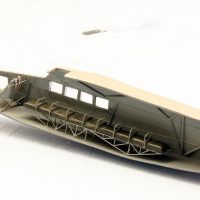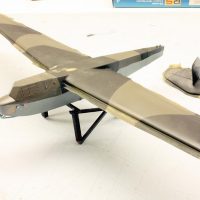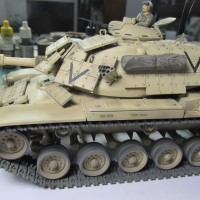Silent into battle: the DFS 230
Gliding had always played a special role in Germany from the pioneering days of aviation. however, in connection with the military build-up of the Nazi regime, the beauty of silent flying was soon to be overshadowed by the military instrumentalisation of soaring.
About the DFS 230
After the end of the war in 1918, when the Allied victorious powers banned all motorised flying in Germany, gliding not only provided a legal loophole but also an opportunity to express opposition to the rigid regulations of the victorious powers. Popularised in this way, gliding enjoyed great attention in Germany in the 1920s. Numerous best performances and records soon testified to the technical and aeronautical mastery of the engineers and pilots involved.
The DFS (German Research Institute for Gliding), which emerged in 1927 from the "Rhön-Rossitten Society", an association of leading aviation pioneers and engineers, must also be seen against the background of this charged enthusiasm for gliding.
The research work of DFS was divided into several institutes; prominent among them were the departments for the development of flying-wing aircraft, which was headed for many years by Alexander Lippisch, and the department for the development of gliding, which was directed by Hans Jacobs, the person who was to initiate the design of DFS 230.
The fields of work of other institutes are also interesting: the development of flight instruments, the testing of aerotow or the possibilities of aerial refuelling were dealt with in separate departments.
The ban on the development of military aircraft prepared the ground for unconventional ideas - and the military had quickly become aware of the potential of silent glider flight. The common interest developed into a lively cooperation between the Luftwaffe, which was interested in innovations, and the busy research centre DFS.
In October 1936, a wooden mock-up of a cargo glider for transporting nine airborne soldiers was completed, and the first flight of the glider, now called DFS 230, took place as early as 1937. In spring 1940, the first series of the DFS 230 was delivered, just in time for the start of the "Western campaign".
The DFS 230 essentially consisted of a tubular steel frame covered with fabric, to which single-spar wings of great aspect ratio were attached. Their leading edges were covered with plywood. A special feature was the jettisonable landing gear, which was only used for take-off. Landing, on the other hand, was always done on a large spring-loaded skid mounted centrally under the fuselage.
The nine airborne soldiers sat close together on a padded bench in the direction of flight. After landing, they exited through two large openings in the fuselage - the term "doors" would be misleading here - and through the pilot's canopy, which opened to the right.
Later DFS 230s had two machine guns to support the air landing and for self-protection. One was fixed in the direction of flight, the second was operated by a gunner in a dramatic pose - he stood with his upper body behind and above the pilot, open in the wind.
Brake rockets mounted on the nose and a brake chute mounted on the tail and still open in the air were also used to shorten the landing distance. The effect of these brute braking methods can hardly be imagined dramatically enough!
The DFS 230 could, apart from the brake rockets and brake chute, offer quite respectable flight performance. With a length of 11.24 m and a wingspan of 21.98 m, the glider took to the air with a maximum take-off weight of 2100 kg. The maximum towing speed is given as 210 km/h, and the glide ratio 12 (fully loaded) also lets the DFS 230 compare favourably with other military cargo gliders.
The high stakes with the surprise potential of novel methods of aerial warfare were to pay off. The first major operation of the DFS 230 was also one of the most famous: the landing and capture of the Belgian blocking fort Eben Emael on 10 and 11 May established the fame of German airborne troops as well as that of the DFS 230. Embedded in the operations of the "Blitzkriege", which was so successful for the German side, the DFS 230 proved itself as a workhorse of airmobile units. It was not until the disastrous losses of the landing on Crete in May 41 that it became clear that the time of successful airborne operations in their previous form was coming to an end.
With the emergence of the "Eastern Front", operational areas soon emerged that posed new challenges to airborne units. The relatively small-scale operations of days gone by receded into the background, while logistics and the maintenance of supplies came to the fore. The DFS 230 was now joined by other cargo gliders that could serve with a much larger cargo volume, designed not only to transport troops but also to move bulky goods.
However, the DFS 230 remained a fixed component in the arsenal of the airborne units, even if it was increasingly used for transport tasks in addition to attack operations. An exception to this rule was the liberation of the "Duce" imprisoned on the Gran Sasso. Once again, the DFS 230 was to shine in a role that was tailor-made for it.
My model shows a DFS of Luftlandegeschwader 1 as it was used on the "Eastern Front" in 1943. The markings are taken from the RS Models kit.
About the kit
The content of the kit offers a quite good basis to build a respectable DFS 230. The sprues of the plastic parts turn out a bit stubby, which can lead to difficulties in separating the numerous small and fine parts.
I would like to judge the fitting accuracy as quite good. However, some parts are cast quite washed out; this applies for example to the representation of the tow release but also to larger parts such as the tailplane. In summary, I can say that almost every part needed a certain amount of finishing before it could be installed.
This led to me replacing individual parts completely. So I used scratched parts from the spare parts box for the tow release, the pitot tubes could be made out of wire, and the two brackets at the wing tips were exchanged for self-made ones. After the connection of the wings to the fuselage seemed to be too weak, I put metal pins and corresponding holes to make a more durable connection.
The fin was treated in a similar way. Here, however, the brass pins do not serve to increase stability, but are intended to increase the degree of realism: on the original, the fin is held at a distance from the fuselage with two struts. Unfortunately, this is not taken into account in the kit.
Although the DFS 230 from RS Models presents a certain challenge, it rewards the modeler's invested perseverance and improvisational skills with high show value and an unusual piece of aircraft history in the display case!




























Beautifuld build and paint scheme! The fortress of Eben Emael in Belgium was raided using gliders in the early hours of May 10th 1940. The capture of the fortress overlooking the Meuse basin allowed mobile formations to enter the low countries on their way to the Channel coast. Well done Roland!
At last a Glider featured here !
The line up of the 3 main gliders of WW2 is really good to see in comparison.
As an ex Para I learned there were only 2 successful airborne operations in history.
Meaning the soldiers did not get scattered after landing And able to use the surprise element to the fullest .
Ében-Emael and Stanleyville 1964.
One in Belgium, the other done by Belgians !
Nice work. Thank you for showing.
Great color scheme ,super job, on all three.
Amazing history, it just goes to show how human ingenuity will always find a way round rules and regulations. Your modelling skills also managed to complete what looks like a "difficult" kit. Definitely liked.
Great glider and ditto scheme, Roland.
Very tiny compared to the Horsa.
History is written by those operations.
This is your usual wonderful model, Roland!
Apart from the excellent build, I love the camo rendition, as well!
Another really interesting model, Roland. And done to your usual standard of excellence.
Thank you very much for your answers - I really appreciate this motivation and your interest!
I didn't realize how small it was until compared with the other gliders. Looks like a precursor to the U2! Nicely done - a cool subject.
🙂 ... Greetings ... 🙂 :
A very stunning and elegant model of this rarely seen glider.
The camouflage scheme does a fine job on setting this one apart from the rest,
really nice work Roland.